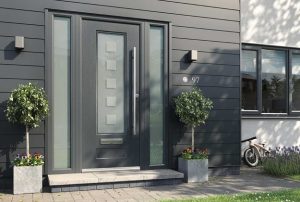Composite Doors’ sturdy construction and varied design have made them famous in the changing building materials industry. The mix of wood, PVC, insulating foam, and glass-reinforced plastic (GRP) gives these doors a high strength-to-weight ratio and durability. Due to this multi-material synthesis, composite doors have the look and feel of wood with its rough finish and rich color variations while being durable and easy to maintain.

Thermally resistant composite doors have a significant layer of insulating foam in the core. This insulation reduces thermal transmission, keeping interiors warmer in winter and cooler in summer, lowering energy use and utility expenses. PVC and GRP outer layers strengthen doors, making them resistant to weathering, collisions, and even the most determined forced entry attempts.
Composite doors are known for their stylistic adaptability. Due to their many colors and finishes, they can practically match wood and metal. This makes them popular with homeowners who want to improve their curb appeal without maintaining traditional materials. Composite doors can match various architectural types, from sleek and modern to warm and classic.
Security is another significant benefit. Composite doors have superior locking systems that extend across the door frame, making them more secure than wooden or UPVC doors. The materials are solid and ideal for outdoor doors that need security.
Despite their benefits, composite doors have drawbacks. They are cheaper than high-end wood doors but more expensive than conventional UPVC doors. This expense can deter some customers, but many feel that durability, security, and energy efficiency justify the higher initial investment.
Composite door weight is another factor. They are heavier than other door kinds and require specific handling and installation. It’s crucial that door frames can handle the extra weight without warping.
Composite doors require less upkeep than wood, but not none. If left in direct sunlight, colors and finishes may fade, especially on darker doors, although regular maintenance can prevent this.
Composite doors are widely employed in business settings. These entrance systems are ideal for organizations with high traffic and difficult operational situations because to their durability and security.
Modern composite doors combine functionality and aesthetics, making them popular for new construction and refurbishment. As consumers choose products based on environmental concerns, composite doors’ excellent insulating capabilities help buildings achieve stricter energy efficiency regulations.
Composite doors will remain popular among architects, builders, and homeowners as demand for durable, low-maintenance, and aesthetically adaptable doors grows. Thanks to material and design advances, they offer an innovative solution that fulfills modern building needs.
 Explore UPVC Windows’ Benefits for Modern Buildings
Explore UPVC Windows’ Benefits for Modern Buildings Contemporary Architecture’s UPVC Door Evolution and Benefits
Contemporary Architecture’s UPVC Door Evolution and Benefits